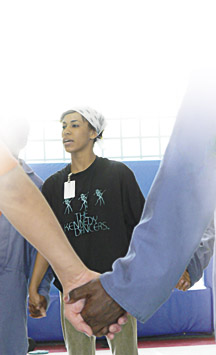The dance class begins like any other. Neck rolls, shoulder rolls, deep bends, and leg lunges – all designed to warm up the 16 dancers gathered for the Tuesday afternoon session.
Soon the dancers, mostly boys between the ages of 12 and 18, will learn dance sequences that will be put together and practiced to music.
“It’s okay if you mess up,” said teacher Junie Kenworthy. “We’re going to go over it many times, so you’ll get it eventually.”
But this class is unlike most dance lessons – the four security guards leaning against the walls are reminders of that. All the students here are youths who have been convicted of crimes and are serving sentences at the Hudson County Juvenile Detention Center in Secaucus.
The class is one of two offered each week at the center by teachers from Kennedy Dancers, a professional dance company based in Jersey City. Last month, the New Jersey State Council on the Arts awarded the company a certificate of excellence for its work at the detention center.
“This is actually a pilot program for incarcerated youth,” said Kennedy Dancers founder Diane Dragone. “We hope to use this as a model for institutionalized youth around the state.”
A normal education
The class is part of the center’s effort to give the youths a more balanced educational experience than incarcerated youth had access to in the past.
“We had to fight to get education incorporated into their time here,” said Robert Murray, division chief of the detention center. “It used to be that kids were sentenced to come here, then when they were released they’d have to make up all the time they missed from school. Now, they’re able to continue their education while they’re inside.”
Many local school districts will now accept the course credits the inmates receive at the center, he added.
Youths sentenced to the detention center get 220 days of classroom instruction and are in class a minimum of four hours a day. (Kids at the detention center are schooled for more calendar days than other students since they are in class for fewer hours per day.) Much of this instruction is in such core curriculum classes as English, math, science, and history.
“The dance class is the only formal creative arts class they have,” Murray said.
Life lessons
Kenworthy, who has been teaching at the detention center for a year, led an energetic class for 16 boys and one girl on Tuesday, a class the kids enjoyed even if they couldn’t mimic her fluid movements.
Throughout the class, she incorporated team-oriented exercises to build trust and other skills. In one exercise, six students stood shoulder to shoulder, crossed arms, then joined hands with the people next to them. Their task was to unravel their crossed arms without letting go of their partners’ hands.
“I’ll frequently add things like lifts or partnering exercises to build teamwork,” Kenworthy said after the class. “The key to that [circle] exercise is communication, because in order to unravel the circle, everyone has to communicate with everyone else, and you have to listen. The way the circle gets unraveled is by each person either going under or over joined hands, or twisting around.”
The better the communication among the participants, she said, the faster the circle is unraveled.
The first group of boys who attempted the exercise unraveled their circle in less than three minutes, which Kenworthy called “record time.”
Such lessons, she hopes, will offer the kids creative examples of how to solve problems once they are released back to their communities.
Not that the kids are thinking about all of that when they’re figuring out whether Kenworthy wants them to turn left or right.
“I like the class ’cause it’s our main exercise,” said Xavier, who, like all the students, was only permitted to give his first name since he is in a juvenile facility.
Another student in the class, Elijah, agreed. “The class is fun, and it gives us something constructive to do,” he said.
According to Dragone, many students at the center develop a deeper appreciation for dance and a “safe form of self expression” because of these classes.
Those who stay out of trouble after their release from detention are invited to take classes for free at Kennedy’s dance studio.
E-mail E. Assata Wright at awright@hudsonreporter.com.
